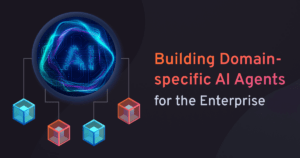An Introduction to Domain-specific Agents
In today’s fast-evolving Artificial Intelligence landscape, Agentic AI systems represent the latest evolution in our journey to build solutions that achieve a more dynamic type of intelligence without compromising quality or performance.
We consider it “Agentic” because our solutions built with this architecture are capable of operating with a high degree of Agency (autonomy). They are adaptable AI agents that require minimal human oversight, make real-time decisions, and understand how to contextually interact with tools in their environment.
When deployed in conjunction with domain expertise or industry-specific large language models (LLMs), these AI agents very rapidly learn how to think like true experts, making it easier for enterprises to deploy AI solutions tailored to their unique needs. The result is a more flexible, efficient, and resilient system that scales as business demands grow.
The Reasoning Engine: Intelligent Orchestration
The reasoning engine is the cornerstone of Agentic AI’s architecture and is responsible for the sophisticated decision-making and goal-oriented planning that defines this novel approach. Like a conductor for an orchestra, the AI Reasoning Engine first ensures the true intent behind user requests is understood, then decomposes the problem into logically executable mini-tasks, and finally routes these tasks to the appropriate sub-agents.
This framework ensures that each request is handled accurately and efficiently, whether it requires the capabilities of natively built AI agents on our platform or external agents connected and managed through our system.
By leveraging domain-specific LLMs, the agents natively understand highly specialized terminology, making it especially useful for enterprise applications where precise understanding is crucial. These domain-specific knowledge bases and AI models minimize misinterpretations and reduce the need for unnecessary back-and-forth clarifications.
Meanwhile, when a request is ambiguous or unclear, the reasoning engine doesn’t just blindly proceed; instead, it engages with the user for clarification when there are missing details relevant to that domain, or contradictory information is provided.
The engine can implicitly cue in on those nuances, thereby allowing a more proactive and productive dialogue with the user which is critical to ensure that the system fully understands the request before continuing.
Decomposition of Tasks and AI Agent Specialization
After a clear understanding of the request is achieved, the reasoning engine decomposes the request into smaller tasks. This decomposition allows for multiple specialized AI agents to work in parallel, each focusing on its particular domain of expertise. This not only increases efficiency but also ensures that the tasks are handled by the AI agents most suited to them, thereby improving the accuracy and execution of complex tasks rapidly.
As AI Agents example, consider a scenario where a manager initiates a request to onboard a new employee. The reasoning engine breaks down this broad request into several smaller, manageable tasks: creating IT accounts, provisioning hardware, scheduling HR orientation sessions, and more. Each of these tasks is routed to the most suitable specialized agent by mapping capabilities and maintaining logical sequences. As each agent completes its respective task, the reasoning engine gathers, reconciles, and integrates the results into a cohesive response.
The reconciliation process plays an essential role here—ensuring consistency and data integrity across tasks performed by multiple agents. This end-to-end agentic orchestration, managed by the reasoning engine, allows for seamless integration of outputs, providing the user with a complete and coherent solution that addresses their original query.
Enhancing Scalability Through Domain-Specific Agent Deployment
One of the most powerful aspects of Agentic AI systems lies in their ability to scale through logical domain separation. By organizing AI agents by functional domains, such as IT, HR, Engineering, and Customer Service, enterprises can deploy highly specialized fine-tuning AI agents to the unique requirements of each department. This modular approach allows organizations to introduce agentic AI gradually, starting with key departments and expanding as needed.
For example, an enterprise might begin by deploying a specialized AI agent to automate HR tasks, such as managing employee onboarding or handling PTO requests. As these AI agents prove successful, the organization can extend AI capabilities to other departments, like IT for user provisioning or Customer Service for automating ticket resolutions.
The modular structure not only facilitates easy deployment but also ensures scaling agnetic AI systems is practical. As new business needs emerge, additional AI agents can be introduced seamlessly, without the need for a complete system overhaul of the parts that are already functioning as intended.
Conclusion: The Future of Domain-Specific AI in Enterprises
As enterprises continue to adopt AI technologies, the ability to create domain-specific agents powered by a central reasoning engine will be crucial for success. Agentic AI’s modular and scalable architecture, combined with its advanced reasoning capabilities, offers businesses the flexibility to address complex, multi-faceted requests while maintaining a high degree of accuracy and efficiency.
The result is a system where AI agents not only automate routine tasks but also adapt to the evolving needs of the enterprise, ultimately driving innovation, improving operational efficiency, and delivering better outcomes. With the power of Agentic AI, the future of enterprise workflows is intelligent, adaptable, and scalable.
Book a custom AI demo download the AI agent benchmark report and see the power of Aisera’s AI Agents today!


